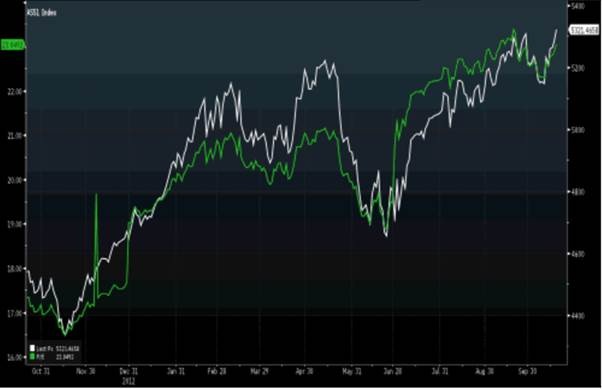Equities make hay while the taper delays
The sharemarket is well placed to experience reinvigorated investor interest as talk of the US tapering timeline pushes out until March next year.
The Australian market has retreated from looking a touch overvalued only a few weeks ago to now being closer to fair value on the expectation of future earnings. As we can see from the graph below, the price of the ASX 200 index (white line) is just leading the price earnings ratio (green line) higher.

Recent bouts of volatility in domestic and international equity markets on the back of taper talk suggest they would prefer the US to maintain quantitative easing. There has been speculation of where equity markets will close the year at, however in the absence of any miserable economic data domestically or from China and the US, investors are indicating they favour the conditions created by loose monetary policy.
What happens in the US has a significant impact on our equity market, exchange rates and long-term bond yields. Equity markets have continued to push higher following the September announcement that quantitative easing would continue in its current form.
Currency markets, as we have experienced since May this year, are extremely sensitive to tapering expectations, or more correctly the lack thereof at present.
While the duration and longer-term impact of a higher domestic currency is difficult to determine, it hasn’t deterred the overall domestic equity market. We do know in the immediate future a stronger currency will once again create difficulties for domestic manufacturers, retail and tourism businesses.
Beyond the direct impacts of exchange rates, the side effects of continuing with quantitative easing mean long-term interest rates remain at historically depressed levels. Investors will be offered no reprieve from lower interest rates, forcing a move towards better returns from riskier assets.
The latest data from the Australian Bureau of Statistics and sentiment surveys suggest investors are starting to lose interest in cash savings, providing plenty of opportunity for new funds to enter into the domestic equity market.
Household savings are at historical highs, suggesting there is a distinct possibility these funds will seek out investments offering a stronger potential for a greater return. Consequently this could turn around the trend of retail investors being net sellers of equities for the past few years.
As the US continues with quantitative easing, investors are left with little choice outside of equities to chase returns in the immediate future.
















